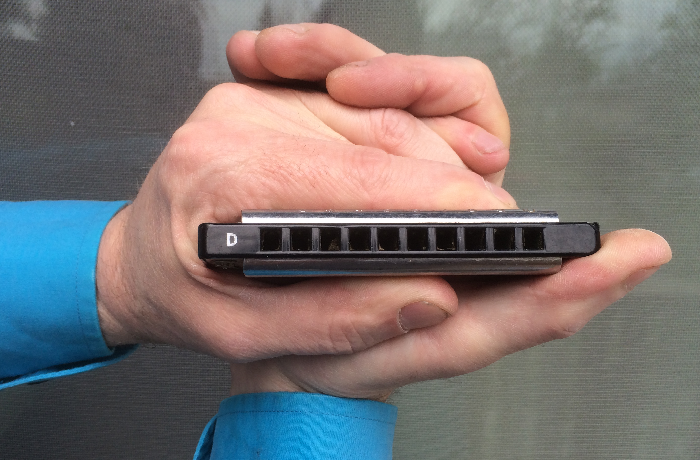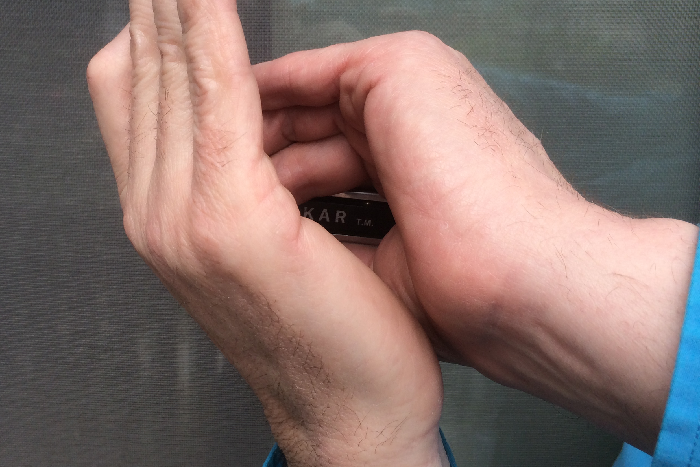Type of Harmonica
- The type of harmonica that these lessons are intended for is, a ten hole “diatonic harmonica”. It is often referred to as a Blues Harp by players. It’s the one that all the cool Bluesy stuff is played on. Blues Harps come in about 12 different keys, depending on the manufacturer or brand name. For the purposes of learning, it is better to begin with a Key “C” harmonica. This is because all beginners instructional material for harmonica tends to be in the key of “C”
- Some popular brands of Harmonica are ; Lee Oscar, Hohner, Suzuki, Seydel.
- Practically all diatonic harmonicas have numbers over the holes, the lowest pitch note being number 1

How to hold your Harmonica





Tablature used on this site.
For the purposes of learning, and if you are not familiar with reading sheet music we are going to use Harmonica Tab or tablature to describe the notes or holes we are playing on the harmonica. Over time there have been many ways of tabbing Harmonica, most involving pictures of arrows to depict inhails, exhails and bent notes. However a convention has developed over time, using pluses (+) Minuses (-) and commas (“). It’s a method that allows tab to the typed easily. Below is a brief explanation.
| +4 means, blow into hole 4 on your Harmonica |
| 4 also means, blow into hole 4 (we don’t always use the + sign) |
| -6 means, inhale on hole 6. |
| -4′ means, a half tone bend on 4 draw. |
| (+1+2) means a blow in holes 1 and 2 at the same time (a chord) |
| (-1-4) is a draw octave played by blocking holes 2 and 3 with your tongue |
| -2″ means, full tone bend on 2 draw. |
| -3″‘ means, bend hole 3 down one and a half steps. |
| 8′ means, blow bend hole 8 down one semi tone. |
| +3…+6 means slide from the 3 blow to the 6 blow |
| 3* means blow into hole 3 with the slide pressed in on a Chromatic Harmonica. |
What Notes are on a Key “C” Harmonica?
There are two notes in each hole, a blow note and a draw note. Study the diagrams below and you will notice that some notes are missing.


“F” and “A” on the lower octave, and “B” on the upper octave are missing. These notes can be played by bending the higher pitched note in that hole down in pitch. This is an advanced technique, and is covered on the Note Bending page.
How to Play a Single Note
Put your mouth over the front of the harmonica covering holes 2 to 4. Then put your tongue on the separator bar between holes 2 and 3. This should block holes 2 and 3, leaving hole 4 open. Blow or inhale on hole number 4. This method for playing a single note is called Tongue Blocking.

Another popular method is called the Pucker or Lip Blocking method, and this is achieved without using the tongue. You just purse your lips, or pucker up.

You should get a clear single note, no double notes. Practice both methods until you get clear single notes every time. Personally I favor the Tongue Blocking Method while playing and feel that it facilitates a broader range of effects. You will find that different people favor different methods and they may even denigrate other methods. Try to learn both methods but you will probably eventually favor one. With enough practice you will be able to play well whichever method you favor.

Some Basic Music Theory
The C major scale goes like this:
C D E F G A B C
This means the same as:
do, re, me, fa, sol, la, te, do.
And it looks like this on sheet music score:

There are also a lot of half notes or semi tones in between these notes. These half notes or semi tones are also known as sharps and flats.
C# = C sharp
Bb = B flat
C#, is a note half a tone above C, and Bb is a note half a tone below B. So from this we can figure out that, C# is the same note as Db
The full range of notes and semitones on a c scale are:
C C# D D# E F F# G G# A A# B C
This can also be written as:
C Db D Eb E F Gb G Ab A Bb B C
And this full range of notes and semitones looks like this on sheet music score:

Notice that there is only a semi tone between E and F, same as for B and C. And now look at the G major scale.
G A B C D E F# G
And the A major scale:
A B C# D E F# G# A
Study these scales and compare them with the full possible range of notes and semi tones. There is a pattern or sequence for major scales, the notes go up in steps.
whole-step, whole-step, half-step, whole-step, whole-step, whole-step, half-step
See if you can write out some other major scales yourself.
For some more advanced music theory check out MusicTheory.net